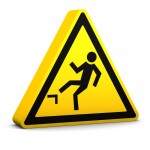 Did you know that businesses have to foot a bill of around £512 million every single year because of people slipping up or tripping over? It can seem as though a slip or a trip is a relatively minor accident, but in fact the costs are tremendous, and not just financially.
Did you know that businesses have to foot a bill of around £512 million every single year because of people slipping up or tripping over? It can seem as though a slip or a trip is a relatively minor accident, but in fact the costs are tremendous, and not just financially.
In addition to the staggering amount of money which businesses end up paying, the cost to the health service is around £133 million, and of course the costs continue when you take into account the individual cost to those who suffer accidents such as these at work, including lost earnings.
Safeguarding Those At Risk In The Workplace
It’s important not to overlook the risk of people slipping or tripping, and it really shouldn’t be that hard. Many of the ways in which slips and trips can be prevented are fairly common sense, and certainly not overly expensive, inconvenient or time consuming.
For example, here is a list of 9 ways in which the risk of slips can be prevented in environments in which there is a risk of spillage or of wet surfaces:
- Identify the most likely causes of a spillage, leakage or other contamination of liquid and determine ways in which, as far as practicable, those risks can be eliminated
- Create effective procedures for dealing quickly and effectively with any spillage
- Install matting or similar flooring solutions to absorb any spillage or moisture, or create a raised surface which prevents any risk of slipping
- Ensure that anyone working in the environment wears suitable footwear and is aware of the need for this
- Design both the workplace and working routines around the risks to limit any potential problems
- Ensure that all equipment nearby is suitably maintained and that the environment is also kept in a good condition
- Identify areas at risk of spillage or of becoming damp and ensure that surfaces are suitable, such as not having smooth, polished wooden floors or mats which could slide on such a surface if wet
- Maintain regular cleaning of the areas
- Provide effective training to all staff responsible for maintaining the area, and provide training to those staff potentially at risk of slipping to raise awareness of both the risk and the appropriate procedure for dealing with or reporting a spillage.
The Risk Of Underestimating The Impact Of A Slip Or Trip Hazard
It’s easy to think that a slip is a simple accident and that most people will simply get up and carry on. It’s no big deal. Yet statistics show that 95% of major slips result in broken bones, and many such slips go on to result in further injuries, such as falling from down steps or from a height.
20% of all injuries which result in workers being off work for more than 3 days are caused by slips, and every year an average of two people die as a result of a slip in the workplace. In other words it’s not an issue to treat lightly, and the advice above needs to be kept firmly in mind.
For further information about carrying out suitable workplace risk assessments of slip or trip hazards, for advice on how to limit the risk or for any other advice regarding slip or trip hazards call one of our friendly Health and Safety Advisors FREE on 0800 1488 677.

A chartered (fellow) safety and risk management practitioner with 20+ years of experience. David provides a healthy dose of how-to articles, advice and guidance to make compliance easier for construction professionals, Architects and the built environment. Get social with David on Twitter and Linkedin.



